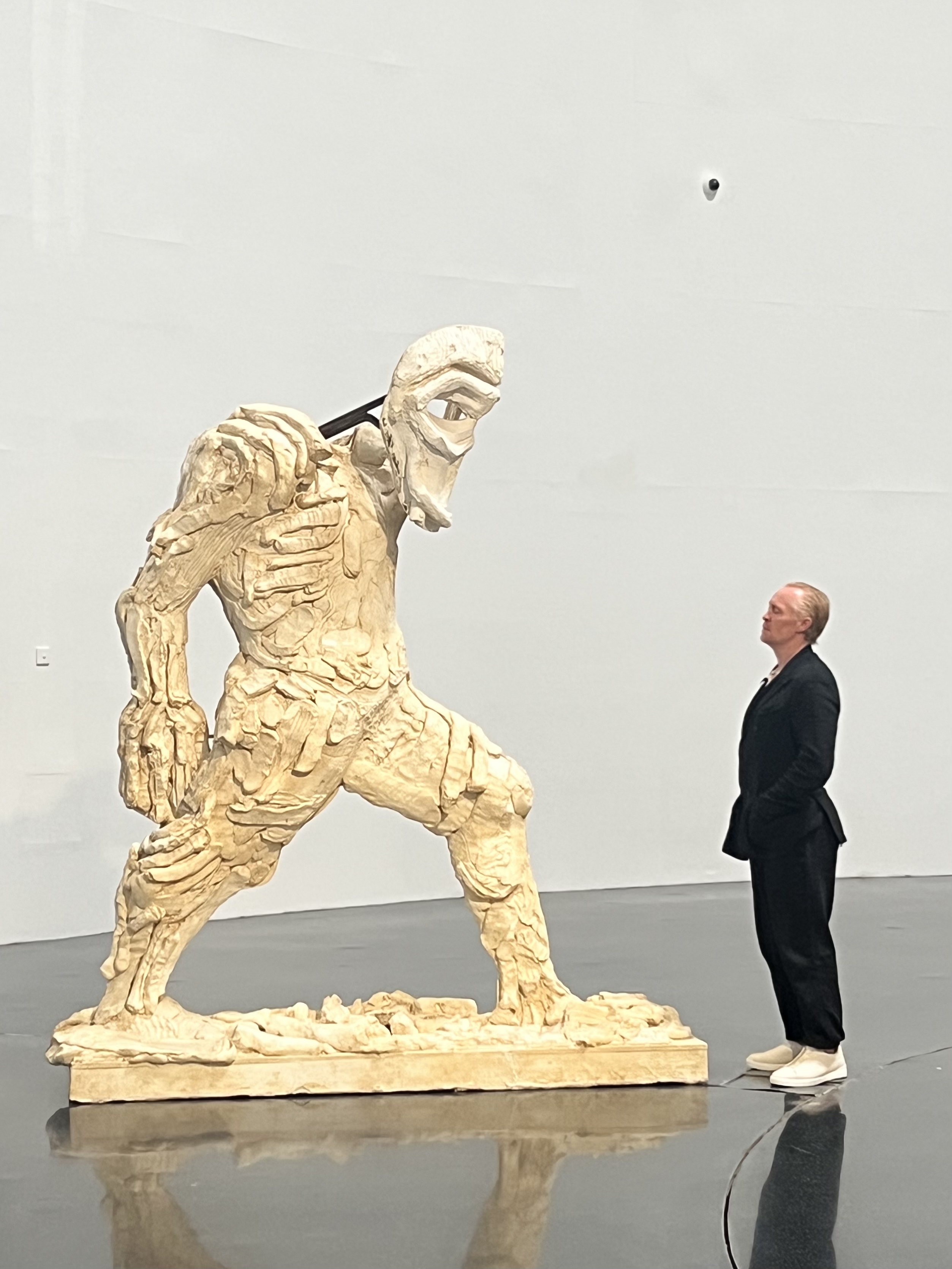Thomas Houseago
“Lovers”
16 September, 2023 -- 28 January, 2024
TANK Shanghai, Shanghai, China
.jpg)
TANK Shanghai is pleased to present “LOVERS”, Thomas Houseago’s first institutional solo exhibition in Asia. Following the artist’s longstanding relationship with the museum since 2012, the inspiration for the exhibition began with the idea of recreating the energy of the artist’s studio in the museum space in China. Titled after the major sculptural work, Lovers (Round Room) (2016), the exhibition features a representative ensemble of abstract and figurative sculptures and paintings which embody the principal motifs that define the artist’s oeuvre from the last decade. This carefully curated selection displayed in the unique architectural setting of TANK invites visitors to become active participants by moving through the space among the artist’s rich body of work.
(6).jpeg)
Bird-eye view of the “LOVERS” exhibition at TANK Shanghai
Central in the exhibition is the sculpture, Lovers (Round Room) (2016), which is a form within a form: a rigid cylinder sits within a slightly swollen, organic sphere. Echoing the temple-like architecture of the gallery, the work consists of two apertures — one vertical and the other pear-shaped, like a womb — which create an interplay of interior and exterior surfaces, light and shadows. The artist encourages visitors to freely step inside and inhabit the space within and surrounding the work. The egg-shaped Sculpture for Kids and Lovers (2022) embodies the same ideas. Reminiscent of Brancusi’s The Origin of the World (1924), Houseago’s sculpture has an ovoid form, yet unlike Brancusi’s solid marble carving, Houseago’s work is accessible but also protective, like a sanctuary. The two architectural Lovers sculptures attest to the artist’s interest in spaces for human interaction, intimacy, and vulnerability — all of which are central themes in his practice — while alluding to the ideas of a new dawn, hope, and the cycle of nature simultaneously.
.jpeg)
Installation view of "LOVERS"
(4).jpeg)
View from inside Lovers (Round Room) at “LOVERS” exhibition at TANK Shanghai
Still Life (2023) is a new painting featuring an open book that carries an inscription from the 2,500-year-old Tao Te Ching by Lao Tzu: ‘The Source. The Spirit of the perennial spring is said to be immortal. She is called the mysterious one. The mysterious one is the source of the universe. She is continually, endlessly giving forth, life without effort’. The chapter has various interpretations but is often thought to describe the origins of the world, which springs forth from the depths of darkness, like a child from the womb. By analogy, it also alludes to the infinitude of creative effort. In this context, the skull does not mean death but its opposite, immortality. Houseago says: “Chinese traditions have influenced me in many ways. The quote by Lao Tzu points to my profound appreciation for its culture and thought. The skull represents the spirit of the perennial spring.”
(3).jpeg)
Thomas Houseago introducing Moon Wane in Malibu 2023 at TANK Shanghai
(4).jpeg)
Installation view of Still Life 2023 (2023) at “LOVERS”
Standing Redwood Man (2023) is Houseago’s latest piece of figurative sculptural production after an absence of nearly 4 years, and is considered by the artist to be his most accomplished sculpture ever made. The imposing contrapposto figure is 368.3 cm in height and is carved with a chainsaw from a massive block of redwood, exemplifying Houseago’s enduring fascination with the human body. Readable from all view points, the sculpture manifests an upward energy which is rare in the artist’s repertoire. The standing man, covered in countless marks carved, or drawn as the artist describes, with a chainsaw, evokes the life of a person who has been through crises, turmoils and losses, and decides to stand strong and continue life with hope despite of all their scars.
(4).jpeg)
Installation view of Standing Redwood Man (2023) at “LOVERS”
Thomas Houseago at TANK Shanghai 2023
From Houseago’s figurative works to his abstract sculptures, and from his new paintings to the most recent carving, “LOVERS” reflects the artist’s journey through the different creative phases of his life in the unique context of TANK Shanghai. It encapsulates the driving forces of his art, such as the history of sculpture, the human figure and psyche, and philosophy, which visitors are invited to intimately explore in the space. Houseago says: “I want the show to tell that story. Some of the works are raw and intense, and as much about the action of painting or carving as about the images. I hope people will be able to move freely between these ideas and experiences, and through my artistic journey.”


